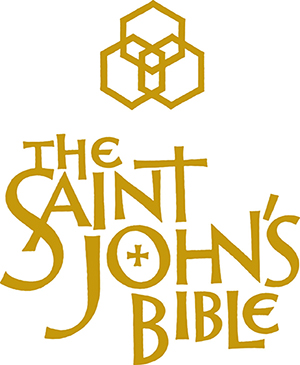Facts: Vison & Values
In the Middle Ages, monasteries helped preserve knowledge and culture for the sake of the greater community. By commissioning a handwritten Bible, Saint John's University in Collegeville, Minn., revived a tradition and affirmed its commitment to the study of scripture, to the book arts and to educational, artistic and spiritual pursuits.
 The Saint John’s Bible is a spiritual, educational and artistic endeavor and a significant contribution to the new millennium. It is guided by the following vision and values:
The Saint John’s Bible is a spiritual, educational and artistic endeavor and a significant contribution to the new millennium. It is guided by the following vision and values:
- Ignite Imagination — With the same dynamic relationship that existed between medieval Benedictine houses and the scribes whose talents they engaged, Saint John's Abbey and University and calligrapher Donald Jackson, in collaboration with many from the wider community, produced a Bible, a work of art, which serves to ignite the spiritual imagination of believers throughout the world.
- Glorify God's Word — A Biblical illumination takes the Word of God and glorifies it by transforming the Word into a complementary art form employing illustration, color and design. The Saint John’s Bible is meant to be a prophetic witness to the glory of the Word of God and to humankind's God-given dignity.
- Revive Tradition — In the Middle Ages, monasteries were centers of culture and learning which kept the tradition of scriptural reading alive for the whole world. They helped preserve knowledge and culture for the sake of the larger human family. In commissioning a hand-written, illuminated Bible, Saint John's revived a tradition that had been nearly absent from the Christian world since the European development of the printing press in the 15th century.
- Discover History — Scholars have speculated about the processes and challenges involved in creating a great manuscript. The Saint John’s Bible allows art and cultural historians the opportunity to experiment in historical discovery, to explore a process that was once a core activity of human civilization.
- Foster the Arts — The Saint John’s Bible, with its spiritual themes and art, reflects the cultural context both of Saint John’s and of contemporary society.
- Give Voice — Inviting various groups to contribute to The Saint John’s Bible extended the arms of churches to the marginalized in the true spirit of Christianity.
Facts: Project Overview
The Origin
Beginning in 1970, Donald Jackson expressed in media interviews his dream of creating an illuminated Bible. Following a calligraphy presentation in 1995, Jackson discussed the idea with Fr. Eric Hollas, OSB, former executive director of the Hill Monastic Manuscript Library at Saint John's University. Between 1996 and 1997, Saint John's explored the feasibility of the Bible project, Jackson created first samples, and theologians developed the illumination schema. The Saint John’s Bible was officially commissioned in 1998 and funding opportunities were launched. The public was introduced to the project in 1999.
- Monumental – In the tradition of great medieval Bibles, The Saint John’s Bible is monumental — two feet tall and three feet wide with 1,100+ pages organized in seven distinct volumes.
 Contemporary – Though each letter is rendered by hand, The Saint John’s Bible used state-of-the-art computer technology to create and manage page layouts as well as employed a modern English translation and contemporary scripts and illumination.
Contemporary – Though each letter is rendered by hand, The Saint John’s Bible used state-of-the-art computer technology to create and manage page layouts as well as employed a modern English translation and contemporary scripts and illumination.- Ecumenical – Saint John’s Abbey and University are dedicated to ecumenism. The text, translation and imagery in The Saint John’s Bible reflect this commitment.
Tools and Materials
The Saint John’s Bible incorporates many of the characteristics of its medieval predecessors. It was written on calfskin vellum using turkey, goose and swan quills. The team of scribes used natural handmade inks, hand-ground pigments, and gold and silver leaf gild.
Layout and Design
A computer was used to size the text and define line breaks. The pages were laid out in full-size spreads with sketches in position. Artists used these layouts to guide their work. Each page is 24 ½” x 15 7/8”, making a two-page spread approximately three feet wide.
- Book headings — Each book of the Bible has an illuminated book heading. Throughout the Bible, book titles appear on each two-page spread written in English on the left page and in its native translation root (most often Hebrew or in some cases Greek) on the right page.
- Verses — Paragraph changes are marked by small colored “kites” alternating in 19th century vermilion water-color (red) and sky blue designer gouache as well as other colors; and the verse numbers appear in the margins. All other verse numbers appear in the line of text and are written with a smaller pen.
- Chapter Capitals — The beginning of each chapter begins with a large decorative capital letter. Each decorative capital in the entire project is different.
- Script — The calligraphic script was specially designed for The Saint John’s Bible by Donald Jackson. Letters are written in lamp black ink from 19th century Chinese stick inks made from carbon.
- Script size — The “x” height describes the size of the script. The small letters are about two millimeters tall. The height of the script is directly proportionate to the size of the quill.
- Columns — Each page has two 4 ¾” columns of script. Columns are justified on the left and the right. There are 54 lines per column, and an average of 10.5 words per line.
- Marginalia — Small decorative illustrations, often created with gold leaf and other gilding, appear in the margins.
- Notations — The official notes from the New Revised Standard Version appear in the lower left and right hand margins of each page.
Theological Briefs
The theological briefs presented composite word-pictures for each of the passages developed by the Committee on Illumination and Text (CIT). The CIT was made up of artists, medievalists, theologians, biblical scholars and art historians. These exegetical (an explanation or critical interpretation of the text) and theological briefs were narratives that varied in length and were in an outline form. They provided Jackson with suggested verses, scriptural cross-references, free association about the text and its imagery, and local association/references to existing works of artistic interpretation.
Illuminations
 The Saint John’s Bible has over 160 illuminations and numerous special text treatments filling its 1,100+ pages. The illuminations were all dictated by a list called the ‘schema,’ a master plan identifying which passages were to be illuminated. The schema was expanded with detailed theological ‘briefs’ giving Donald Jackson full background on each passage. The schema also stated how large each illumination was to be. Jackson’s process in preparing to illuminate a passage was similar to the monastic practice of Lectio Divina, a careful mulling over the text, looking at the details, thinking, meditating, and letting it sink in.
The Saint John’s Bible has over 160 illuminations and numerous special text treatments filling its 1,100+ pages. The illuminations were all dictated by a list called the ‘schema,’ a master plan identifying which passages were to be illuminated. The schema was expanded with detailed theological ‘briefs’ giving Donald Jackson full background on each passage. The schema also stated how large each illumination was to be. Jackson’s process in preparing to illuminate a passage was similar to the monastic practice of Lectio Divina, a careful mulling over the text, looking at the details, thinking, meditating, and letting it sink in.
Biblical Themes
The Saint John’s Bible speaks of the 1,500-year-old tradition of Saint Benedict and his Rule, and the following Benedictine values in particular:
- Hospitality – The Rule of Saint Benedict says the guest should be received as Christ. The Saint John’s Bible speaks to hospitality for the poor, the pilgrim, the seeker and the stranger.
- Transformation – Benedictines take the vow of conversatio or conversion of life. Conversatio entails an ongoing process of aligning one's life more closely to the life of Christ.
- Justice for God's People – Of special concern to Benedictines and all believers in biblical revelation is the constant call for justice for all of God's people who are equally worthy before God.
- Benedictine references – each scripture passage referred to by St. Benedict in the Rule is marked with a special cross in The Saint John’s Bible, connecting this Bible to the Benedictines in Minnesota.
Facts: The Gospels & Acts
There are seven distinct volumes in The Saint John’s Bible each with their own illuminations or special treatments and characteristics. These seven volumes contain the 73 books of the Old and New Testaments. The volume is on exhibit here at OLV National Shrine & Basilica is The Gospel and Acts.
The Gospels and Acts
The Gospels and Acts volume was completed in May 2002. It is heavily illuminated with more than 25 illuminations including full-page frontispiece illuminations for each of the four gospels and several others throughout its 136 pages. Some of the prominent illuminations included in the first volume that have been filmed, displayed or written about are the Genealogy of Jesus, Birth of Christ, Raising of Lazarus, Crucifixion, Christ Our Light, Last Supper, Road to Emmaus and Pentecost.


 Get to Know the Saint John's Bible
Get to Know the Saint John's Bible